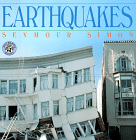Featured Author: Seymour Simon
Carol Hurst's Children's Literature Newsletter Summer 1999, Page 5, by Carol Hurst and Rebecca Otis.

This is an excerpt from Open Books: Literature in the Curriculum Kindergarten through Grade Two by Carol Hurst. Published by Linworth ISBN 0938865773. Order through Amazon.com or call Linworth at 1-800-786-5017.
His Life:
Seymour Simon was born on August 3, 1931 in New York City, the son of David and Clara Simon. His love for writing became more pronounced during his years as a high school student at the Bronx High School of Science. One of his projects there was the grinding of his own telescope lens. After graduating from the City College of New York City, Seymour Simon taught school for more than twenty years before becoming a full-time nonfiction writer for children in 1979. By that time he had written fifty science books for young people. His first book was Animals in Field and Laboratory. He and his wife, Joyce, a travel agent, live in Great Neck, Long Island, New York and are the parents of two grown sons, Robert and Michael.
His Work in General:
Simon's interest in science is exuberant and he approaches every subject with a child's eye for interesting tidbits but he is careful not to overstate the facts. His books fascinate any reader partly because of his careful choice of dramatic photographs but also because his information is so well stated. He never leaves his readers thinking that this is the full story or even that scientists know the full story of any subject. He always leaves the door open for future information.
Things You Might Like to Do with His Work in General:
Categorize his books according to subjects.
Find another book about the same subject as any of the Simon books. Compare the way he gives information and what information he gives with that of the other author.
His Books:
Big Cats. HarperCollins, 1991. ISBN 0060216476. Order Online
Seven members of the cat family are used to point out similarities and differences between them illustrated with full color photographs.
Activity: Bring a pet cat to school. Observe it carefully and make comparisons to the look or action of any of the big cats in Simon's book.
The Dinosaur Is the Biggest Animal That Ever Lived and Other Wrong Ideas You Thought Were True. HarperCollins, 1984. ISBN 0064460533. Order Online
The title is Simon's longest but the book explodes thirty common myths about science.
Activity: Use the thirty myths in this book as a quiz for parents and others who have not read this book.

Earthquakes. Morrow, 1991 ISBN 0688096336. Order Online
Simon's look at earthquakes includes enough information about the damage in San Francisco and Mexico City without sensationalizing the subject. Equal attention is given to the geologic causes and results of earthquakes as well as the effort to predict them.
Activity: Find out when the last earthquake occurred closest to your area. What damage did it do?
How to Be an Ocean Scientist in Your Own Home. HarperCollins, 1988. ISBN 0397322925. Order Online
There are twenty-four experiments and explorations with saline water in this book which can provide inspiration for many science projects.
Activity: Form groups of two and perform one of the experiments in this book taking careful journal notes as you do so. Post your notes and compare them with others who chose the same experiment.
Mars. Morrow, 1987. ISBN 0688065848. Order Online.
Using color photographs and information gathered by Mariner and Viking probes, Simon tells us what is known but also what is yet unknown about this more familiar planet.
Activity: Find Mars in the night sky.
Neptune. Morrow, 1991. ISBN 068809631X. Order Online.
Full of interesting facts about the eighth planet from the sun, this book uses photos and information gathered by Voyager 2 as it flew by in 1989.
Activity: Make a list of the things we found out about Neptune with Voyager 2.
Snakes. HarperCollins, 1992. ISBN 0060225297.Order Online.
Facts about snakes: their predators, their prey, the way they move, reproduce and live are illustrated with visually stunning photographs.
Activity: Take a poll among the adults you know concerning their feelings about snakes.
Uranus. Morrow, 1987. ISBN 0688065821. Order Online.
Much of Uranus is still a mystery even after the pass by Voyager 2 in 1986. Simon talks about its strange tilt and forty-two year days among other fascinating material.
Activity: What do we still not know about Uranus?
Whales. HarperCollins, 1989. ISBN 0064460959. Order Online.
Many kinds of whales are shown with gorgeous photographs in their natural habitat. Simon compares their size to things within the child's world. The humpback whale is "longer than a big bus and heavier than a trailer truck" for instance.
Activity: Do further research about any one of the whales mentioned in this book.
Wolves. HarperCollins, 1993 ISBN 0060225319. Order Onlne.
Concluding with a plea to preserve and protect them, the book first shows us how they live, hunt and raise their young. They are compared and contrasted to their relatives in an almost chatty style. Again, the photographs dominate the book, but the text is clear and fascinating. See also Wolves by R. D. Lawrence.
Activity: Find and bring in recent newspaper and magazine articles about the reintroduction of wolves to some areas.
![]()
Related Areas within Carol Hurst's Children's Literature Site
- Open Books: Literature in the Curriculum Kindergarten through Grade Two professional book by Carol Otis Hurst. Ordering information and other sample chapters.
- Earthquakes by Seymour Simon. Book Review.
- Oceans by Seymour Simon. Book Review.
- Other Author Studies.
![]()
Related Areas on the Internet
- Seymour Simon's Web Site.
- Amazon.com Bookstore's listing of Seymour Simon's books.
![]()
Go to Next Section of Newsletter: Behind the Desk
Return to Table of Contents of the Newsletter.
Advertisement:
Advertisement:
Advertisement:

